BAIKAL ROUND-THE-WORLD.
 People are followed by things to do,
People are followed by things to do,
People follow the money,
They try to escape shame and sadness.
And I follow, follow the fog,
The dreams and the smell of taiga.
(Y. Kukin)
Saloon of ship “Valeriya” is swaying quietly on the Baikal’s waves; the thoughts start moving quicker through the head hurried by the sound of the motor, and outside the illuminator there is only indescribable beauty. A thoughtful young man is sitting with his laptop, trying to lure in the muse and get some inspiration from her. This is probably the best time to start a ship journal about our adventures. So, get comfortable, pour yourself some tea, take a cookie, and listen.
To embrace the un-embraceable is the principal that our friendly group lives by. To create a route, that in two weeks would show the greatest lake in the world, and not miss out on any of the lake’s glories is as challenging as planning a trip to the Moon. However, as it is said our hands should not be bored, the body should not just rest on the sofa, and brains should not just follow the TV. We said – we packed – we went ahead. There were sixteen of us; out of the sixteen there were 5 adult divers, 3 children divers, 6 adult non-divers, 1 child non-diver, and entomologist Paganel. Our trip started at the delta of river Angara and went north, along Olkhon Island’s eastern shore, and further north past the eastern shore of the lake to bay Ayaya. Afterwards we headed back south, along the lake’s western shore, through the strait of Maloe More (Sea), and further to the south of Baikal. It is worth noting that the last time a trip of such scope took place was 10 years ago, and there was probably none before that. Our “Baikal Round-the-world” combined diving, fishing, underwater hunting, hiking and auto-safari!
Day one: The Empty Airport
The start of this trip was supposed to be quite simple: a flight from Domodedovo to Irkutsk and transfer to village Listvyanka, where we would board a ship that would be our home for the next twelve days. However, some of our team members were from an infamous children’s group “O-OOPS!”, hence the trip could not go completely according to plan. As Russian cartoon character, captain Vrungel, once said: “The ship will go as you name it”. So our first “OOPS!” came fast, and flight attendant’s sexy voice informed us that due to an inclement weather we are landing in Ulan-Ude (Buryat Republic) instead of Irkutsk.
We got off the plane and moved to a shaky building of the local airport to wait for the fog to lift off Irkutsk, and we started emptying weeklong stock of local buffet. When it was time for us to get back on the plane, our second unexpected “OOPS!” came along. Several passengers decided that they like it here just as well, and would like not to continue their trip on the plane. Maybe you can guess what happened next; it became impossible to take off the plane the necessary luggage. After talking with the loaders and arguing with the flight attendants, the plane took off. Quite unexpectedly, we received all 19 pieces of luggage in the airport in Irkutsk, and had only one hour remaining until our next destination. The weather greeted us with rain, but oh well. As one of my friends said, «That is life. Life is hard». When we got to the ship, we organized equipment in the boxes and people into cabins, and finally fell asleep.
Day two: Getting to Know Baikal
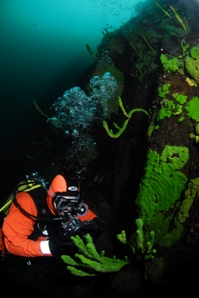
The first morning has proven right away that all the yesterday’s challenges were worth it. Mother Nature has really worked hard on this place. Olkhon Island’s steep eastern bank is covered with larch and goes straight down to clear blue water. We were enjoying the rays of morning sun and seriously doubted whether this beautiful landscape is for real. We took a walk on the pebbles along the water; we had a tough choice whether to dive or to take a better look around on the surface. However, the duty was calling and we had to start getting warm undergarments on and deal with dry suits. All of that was not tiring at all, but more so exciting – this is what we came here for.
Unfortunately, we were a little unlucky on this dive. The lake is very famous for its water transparency and visibility, but we got to see 10 meters ahead, and then … just green-and-blue mist. Even though we were slightly disappointed by this fact, we kept going deeper and were rewarded – the visibility kept improving, and at 30 meters we got the type of visibility that was promised to us.
Diving in the lake is its own genre. It is hard to imagine that you’re not in the salt waters of a sea or an ocean, but in fresh water, which is suitable for drinking. Beautiful underwater cliffs, covered with unique sponge, send mysterious vibes; if there are any magical creatures in our world, they definitely live somewhere around here. We got a chance to see some of such creatures - numerous snails and shrimp - gammarus; they all looked very interesting and unreal.
Day three: Nerpa

Ushkanii or Hare Isles are one of the most interesting places in entire Baikal, mainly because here there is a large habitat of Baikal seal, nerpa. This fresh-water seal is another wonder of the local nature, as its closest relatives live thousands kilometers away. These isles are a part of natural reserve and you need a special permit to see nerpa’s habitat. This permit you can get from local huntsmen, and then you go through island Tonkij, and hide in the rocks and bushes, that are covered with camouflage net. Nerpa is a very clever animal, with a personality, and most importantly with a great eyesight. If nerpa notices you, all you’ll see are nerpas’ heads bobbing in the water. I must say, they’re extremely positive creatures.
Diving was planned at another island, which has a name that speaks for itself Kruglyj (Russian for “Circum”). People, who named islands around here were incredibly “creative”, the archipelago has islands Kruglyj, Dolgij, Bolshoj and Tonkij (trans.: “Circum, “Long”, “Big”, and “Narrow”). There was not much improvement in the visibility on the small depths, so we h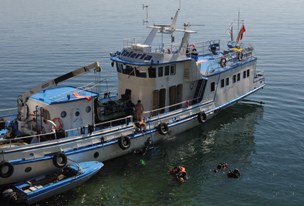 ad to go down to thirty again to take some good photos. We found lots of great sights, but we could not stay at thirty for long. The ship was awaiting us with a tasty lunch, fishing and relaxing time, and completely erased any regrets about not a 100% perfect diving conditions.
ad to go down to thirty again to take some good photos. We found lots of great sights, but we could not stay at thirty for long. The ship was awaiting us with a tasty lunch, fishing and relaxing time, and completely erased any regrets about not a 100% perfect diving conditions.
By the evening we reached Chivyrkuiskyi gulf, where there are sulphuretted hydrogen hot springs. The water here is warmer, a whole 17 degrees, and it gets up to 35 in the springs. It is good for you to sit in these mini-baths, but unfortunately they smell like rotten eggs, so it is hard to spend a long time there. By the way, do not forget to take any silver jewelry off yourself, unless you want to watch an intriguing chemical reaction.
Besides everything else, Chivyrkuiskyi gulf is rich in fish, especially pike, which spends almost entire year here. Luckily one of us practices underwater hunting, and we had a great pleasure to have some cutlets made out of freshly caught pike later.
Day four: Grinpin Quagmire
We reached almost the very north of Baikal – a bay with an interesting name Ayaya (interestingly, there is also bay Aya, evidently it’s one “ya” calmer there). The north of the lake is curious because it is practically uninhibited. There is only one town there, Severobaikalsk, and besides it only woods and huntsmen huts, with no roads leading to them. You can get to these places only by water, and there are only a few people who have witnessed this beauty. The first thing that gets your attention are mountain peaks, which are covered with snow and shine in the sun. Nearby there is a hard-to-reach, and hence almost untouched lake Froliha, which, as it is said, has some fish in it that existed back in dinosaur times. It is a shame to pass on such an opportunity to see this unique place, so sixteen of us took off on a hike, Lord of the Rings style. We were warned that the hike is seven kilometers long, but they forgot to mention what kind of paths we will be walking on.
We jumped around bog hummocks and fallen trees for about three hours, and our boots were soaked through. We kept expecting the hound of Baskerville to show up, but, trust me, the lake was worth it. I am still not sure whether there is any prehistoric fish in it, but that it is gorgeous – I promise. It’s a real forest lake, hidden among the trees, and not a lot of people go there. You can swim and drink the water, immersing completely into nature, especially if you realize that maybe only another dozen of people swam here before you.
A nice addition was a whole bag of orange cap mushrooms, which we were able to gather. These words are written right about an hour after the consumption of those mushrooms, and if you see text further on it means that mushroom dinner went well!
Day five: Shore of Brown Bears
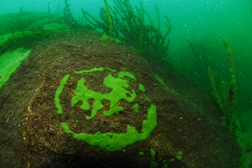
Well, if you see this text, it means that mushrooms were excellent! It is known that there is only one way from the top, down. Hence once we reached the very north of Baikal it was time for us to move in the other direction. We went along the western shore of the lake, the northern part of which is called the Shore of Brown Bears. Truly there are quite a few of these fury state symbols here; however they come out to the shores only in June, to taste the water in the streams. We made first two dives near river Ledyanaya that flows out from mountain glacier. The night before, following the tradition, we pleased the great spirit of Baikal with vodka, and this time it granted us an excellent visibility (around 30 meters) and a great wall, that goes down to the abyss at a perfect straight angle. However, the water temperature got only to 7.5 degrees. The consequences of such temperatures came shortly, some of our regulators began to freeze and stand at free flow at thirst opportunity, even though they are proudly called “unfreezing”. Such conditions didn’t bring our mood down, and only added the necessary experience. Considering that half of the divers were children, who have a very limited experience of diving in dry suits, such conditions were a great practice.
In the evening our hospitable host, the huntsman, treated us with delicious, fresh grayling, and wonderful banya. To jump into icy waters of Baikal after banya is much better than running into the snow. While we were in banya a thick fog came  down from the mountains to the water, so it seemed that from Russian banya we ran straight out into Turkish sauna. The whole scene was unforgettable, just imagine: a ship is barely visible through milk-white fog, somewhere at the end of sight a cold water is splashing, and a crowd of hot people are running towards it. A very curious cook, a huge druggie nicknamed Tyson, smoked grayling, for us. We’re not sure why Tyson, but just in case everybody hid their ears from him. And we say druggie, because while the fish was smoking, he watched the process very attentively and kept smelling the smoke… At the same time the huntsman kept telling us local stories about how the concentration of bears in this region reaches up to 36 animals per square kilometer, and that he regularly feeds one of the bears. Our imagination immediately created a picture how a real Russian man in Russian fur-hat is going into the woods with balalaika, drinks up a bottle of vodka together with the bear, and they start a fight. It’s not a surprise that this year’s Russian Olympic team has whole three gold medals in… wrestling!
down from the mountains to the water, so it seemed that from Russian banya we ran straight out into Turkish sauna. The whole scene was unforgettable, just imagine: a ship is barely visible through milk-white fog, somewhere at the end of sight a cold water is splashing, and a crowd of hot people are running towards it. A very curious cook, a huge druggie nicknamed Tyson, smoked grayling, for us. We’re not sure why Tyson, but just in case everybody hid their ears from him. And we say druggie, because while the fish was smoking, he watched the process very attentively and kept smelling the smoke… At the same time the huntsman kept telling us local stories about how the concentration of bears in this region reaches up to 36 animals per square kilometer, and that he regularly feeds one of the bears. Our imagination immediately created a picture how a real Russian man in Russian fur-hat is going into the woods with balalaika, drinks up a bottle of vodka together with the bear, and they start a fight. It’s not a surprise that this year’s Russian Olympic team has whole three gold medals in… wrestling!
Day six: Pokoiniki (The Deceased)
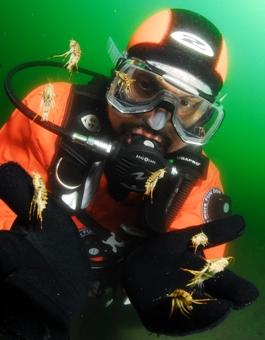
Early in the morning the weather was a complete contrast to last night’s calmness. The wind blew very hard, tearing off the suits, which were tied to the ship; and the ship’s bell rang all the possible alarms on its own. To tell you the truth, the weather here changes several times a day. After a shaky ride, we reached the shore with a very upbeat name Pokoiniki (Russian for “The Deceased”).
You have to agree that this name is a little bit strange for a very picturesque shore, covered with young larch, and inhabited by wild horses. Actually this name was given to the place after some expedition had some mushrooms around here and everybody passed away shortly. At first I thought that there must be something mysterious about this, but after looking around realized that there are simply no eatable mushrooms around here.
The dive went great despite of the weather and we were able to get a great photo with gammarus.
There was a big group of gammarusses, which were collected by one of the divers. Must be quite an interesting task….
We took a walk on the shore and tried to find wild horses, there is a herd of 19 here. Unfortunately we didn’t see any horses themselves, but saw plenty of their tracks.
Day seven: Olkhon
After we passed through the strait of Maloe More, our ship “Valerija” reached the largest island of Baikal. We already saw some of Olkhon’s gorgeous eastern shore, though the western shore of the island is cardinally different. Instead of the mountains covered with larch, there are just fields. We got into two vans, and following the so-called “road” drove to the north of the island – to “Three brothers”.
That is the name for three very picturesque cliffs – one of the most breathtaking place that I have visited in my life. The cliffs drop from almost 100 meters down to the turquoise water…The atmosphere is really magical. I would not be surprised if a dragon flew from behind one of the cliff, or if a group of elves started running towards us…
The most northern part of the island is just as beautiful; it is cape Khoboi (which in Buryat means “Fang”) and is called so because its flat cliff looks like some animal’s tooth. We sat down at the edge and dangled our legs. We ate hot uha (fish soup) made out Baikal omul, which was cooked over the fire, and truly brought us closer to paradise.
Day eight: The Pearl of Baikal
It is very interesting to follow how the shores’ landscapes change as our trip goes along. First we saw the majestic cliffs, which are followed by woods on the plains, fields follow woods, and the mountains covered with trees change fields. The lake may seem not that large, but there are so many various nature zones around it! Once we left the fields of eastern Olkhon we started to see mostly mountains covered with cedar and larch, with picturesque gorges in between them. The water changed as well: first of all, it became warmer and secondly now there was a lot more sponge and gammarus.
In the evening we reached bay Peschanaya that is called the “Pearl of Baikal”. The name may not be quite correct, as Baikal is one big pearl itself, but not the point… This bay is very cozy with a sandy beach that has “walking trees” on it. These trees are larches, roots of which were uncovered from the sand by the wind, and now resemble legs.
If you hike up the steep slopes to the top of the cliff that hangs over the bay you will see another wonderful view. Maybe this view is not as impressive as at Olkhon, but still worth a picture.
Day nine: Bolshie Koty
Have you seen a movie “The Cold Summer of 1953”? Bolshie Koty fishing village reminded me just of the village from that movie. It is not quite the village as you may think about it, but more so a mixture of a village culture with summer houses. The peculiarities of Russian villages are here all around, such as cows and horses quietly walking around. Sometimes I think that I would like to live like this as well, in a quiet village by the lake, heat a wood stove in a cozy village house, and in the morning go fishing in an old boat. Probably everybody who is daunted by the life in large cities has such dreams.
By the way, this village even has its own small museum. The two halls have exhibits of Baikal’s flora and fauna. Even though this museum more so reminds of a biology lab at school, for those who are interested in nature it is still neat (and if you’re not interested in nature, then why did you come to Baikal?). What else? Oh yeah, diving… Well an incredible place is Bolshie Koty!
Day ten: Kolchak’s Gold
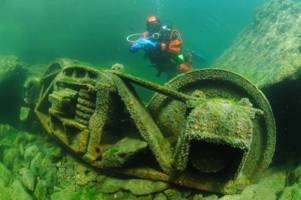 Our voyage is slowly coming to an end and we got to the very south of the lake, where the Circum Baikal Railroad follows the shores. It is believed that several train cars crashed here during the Civil War, and that those cars were carrying gold bars of a famous admiral. The train cars are really there, at 110 meters deep, which is far beyond our recreational diving abilities. Nobody has found the gold in them thus far, but every diver still tries and hopes that he is the lucky one.
Our voyage is slowly coming to an end and we got to the very south of the lake, where the Circum Baikal Railroad follows the shores. It is believed that several train cars crashed here during the Civil War, and that those cars were carrying gold bars of a famous admiral. The train cars are really there, at 110 meters deep, which is far beyond our recreational diving abilities. Nobody has found the gold in them thus far, but every diver still tries and hopes that he is the lucky one.
One before last dive of this trip was ironically made at a place called “One-before-last tunnel”. There are two interesting things around here. Firstly it is small blue gammarus, which hide under each stone. It is quite hard to take a picture of it, because as soon as you lift a stone of its head it runs under another one.
The second thing is a canyon that starts at 5 meters and goes down to 60. At 25 meters the canyon is crossed by a tree, which creates sort of a bridge.
The second dive was done at wall Katorzhanka. This is the place where the train cars have crashed. Wheels of one of them are at three meters, the rest are in the abyss. For those who are not interested in gas mixes and techno-diving, there is also a wall to see. There is almost no sponge here, but plenty of gammarus and interestinglandscape formations.
Oh yeah…. We haven’t found the gold…
Day eleven: Pozy and Buddhism
One of the songs says, “All our meetings are followed by separations”, and it was time for us to say our good-byes to the hospitable “Valerija” and to get off on the shores of Buryat Republic. Ahead of us there was a road trip to Ulan-Ude (thankfully not to the airport, but to a hotel), and then a visit to Ivolgin Datsan – a main center of Russian Buddhism. On the road we had a chance to try the main dish of Buryat cuisine – pozy. Pozy is like large pelmeni (ravioli) with an open top. You eat them with hands: first you drink the bullion through the top, and then eat the ravioli itself. When you eat pozy you have to drink tea with milk. As any student who lives alone, I know what good pelmeni is, and with all responsibility I say – this is much better.
Ivolgin Datsan is the largest Buddhist monastery in Russia, and it is located near Ulan-Ude. It is famous for being a home to the only known human who now lives in somatic state (a dream close to coma state). This person reached somatic state around October Revolution time (when he was around 60), and he is still alive. When he went to sleep he said that he will wake up when life will become unbearable and people will truly need his help. Apparently, not everything is that bad on our planet yet.
Besides him there a real alive people in the monastery none of who are Buryats, but natives of Tibet. Each of them specializes in some field: some are healers, some astrologists, and so on.
Once again I saw that Buddhism is a more humane and optimistic religion out of all existing. If I will ever start believing in god, it will probably be Buddha. There are no strict prohibitions, violence, self-torture in order to save your soul. Besides, Buddhism is very convenient: as you go around the monastery (clockwise, as the Sun) you will see “drums”, which have mantras put in them. To understand them you need to be able to read in Tibetan, you just have to roll the drum – and that’s it, you read the mantra and better your karma (and there are thousands per drum!). Convenient, isn’t it?
Day twelve: The Last “O-OOPS!”
Our trip was coming to an end, and as it is said in another song: “We’re going back to the chaos of the cities and into the traffic- and there is no escape”. We took a bus from Ulan-Ude to Irkutsk, and we spent our last evening in Siberia in an out-of-town hotel called “21st kilometer”. It is a very neat hotel complex made up of several wooden houses, and even with its own mini-zoo, that has a lazy bear Misha, a hungry lynx Vasya, a Mongolian yak Tosha, and an energetic sable Kuzya. There were lots of toasts at our last supper, and almost all of them were “To Baikal”. This difficult trip was great; there was nobody who felt unsatisfied. And it is good that not everything was ideal, because it means we have a reason to come back here again.
What is notable, there was not a lot of “Oopses” during this trip. Probably to fix that our driver slept through and was late picking us up at the hotel, and we were almost late for our flight. But this why we’re called “O-OOPS!”, because we know how to deal with challenges!
I would like to say a few words in conclusion. In my short lifetime I have seen lots of wonderful places in the world, and most of them were in far away countries. And finally I have found a paradise on earth, and not somewhere behind the border, but in the country, where I was born and grew up. It is good to realize that Russia also hides away places in nature, that haven’t been touched by human, that have seen Chingizkhan, and where the water in the lake is as clear as it was during cavemen times. At places like this one realizes better how wonderful our world is, and how important it is to save it for our children. You feel the power of nature, and how miserable is the man who tries to destroy it day after day. There is another song that was written by a musician and a diver, which says very correctly:
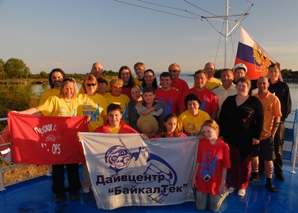
“I have never believed that God created this world for people,
That is why it is so wonderful without them, that it is hard to describe…”
P.S. Team “O-OOPS!” would like to express deep gratitude to dive center “BaikalTek” and its leaders for their help in the organization and participation in this trip, as well as to ship “Valerija” and its hospitable team (personally, I bow down to the chef!). Thank you, people - the trip would not be the same without you!
Artem Melamed. Magazine "Neptune" №5 2008